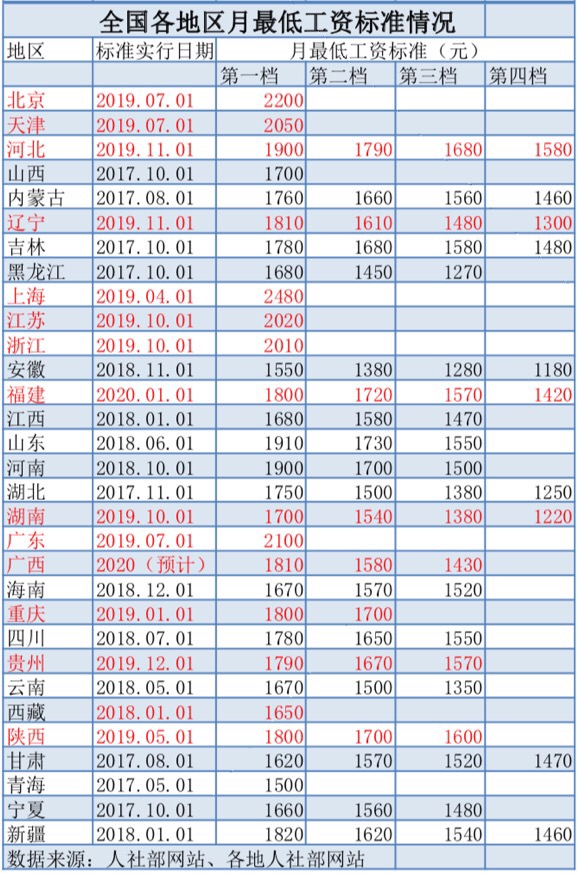The rate of increase of the minimum wage is in line with the trend of slowing macroeconomic growth.
The adjustment of the minimum wage has always been closely linked to the income of most workers such as the unemployed, paid vacation leave, and medical workers. As the year approaches, the provinces that have raised the minimum wage are also increasing.
Judging from the updated minimum wage standards by the Ministry of Human Resources and Social Security, as of the end of November 2019, the monthly minimum wage standards in six provinces of Beijing, Shanghai, Guangdong, Tianjin, Jiangsu and Zhejiang exceeded 2,000 yuan. Among them, Shanghai led the nationwide monthly minimum wage list with 2,480 yuan per month.

Edit and organize
In terms of hourly minimum wages, the hourly minimum wages in Beijing, Shanghai, Tianjin, and Guangdong all exceeded 20 yuan, of which Beijing ranked first with a minimum hourly wage of 24 yuan.
According to the Minimum Wage Regulations, the minimum wage standard generally takes the form of a monthly minimum wage and an hourly minimum wage. The monthly minimum wage is applicable to full-time employed workers, and the hourly minimum wage is applicable to part-time employed workers.
Specifically, the monthly minimum wage in Shanghai has been adjusted from 2420 yuan to 2,480 yuan, which has ranked first in the country for four consecutive years since 2016. The hourly minimum wage has been adjusted from 21 yuan to 22 yuan.
The monthly minimum wage in Beijing has been adjusted from 2120 yuan to 2200 yuan, an increase of 80 yuan; the hourly minimum wage is 24 yuan, which is the same as the original standard. In addition, Guangdong ’s monthly minimum wage was adjusted to 2100 yuan, Tianjin to 2050 yuan, Jiangsu to 2020 yuan, and Zhejiang to 2010 yuan.
Due to the different levels of economic development in different regions, there are differences in the living expenses, average wages of employees, and unemployment rate. Therefore, there is a large gap in the minimum wage standards.
In terms of public information, the minimum monthly wage standard in Beijing, Shanghai, Guangdong and other places exceeds 2,000 yuan, while the monthly minimum wage standard in some regions such as Liaoning, Anhui, and Hunan is more than 1,100 yuan. In addition, taking Hunan Province as an example, the minimum hourly wage is 12.5 yuan, which is nearly double the rate of Beijing.
The minimum wage is adjusted every 1-3 years. It can be seen from the timeline that since 2010, Shanghai has raised the minimum wage for 9 consecutive years, and the monthly minimum wage has been increased cumulatively.It was 1360 yuan, showing a steady growth trend.
In addition, there are many provinces where the minimum wage adjustment interval is relatively long. According to data, the distance between Hebei and the last adjustment of the minimum wage is about three years. Inner Mongolia, Jilin, Heilongjiang, Hubei, Gansu, Ningxia, Guangxi and other places The last increase will also be two years old. Therefore, if the relevant policies are not adjusted, the minimum wage standards in many places are expected to increase in 2019.
It is understood that Hebei and Liaoning have implemented the new minimum wage standard since November, and Guizhou has implemented it since December 1. The Fujian Provincial Department of Human Resources and Social Security also issued a notice recently announcing that from January 1, 2020 Starting today, the minimum wage standards will be adjusted across the province.